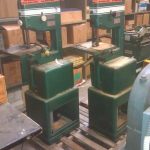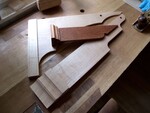We may receive a commission when you use our affiliate links. However, this does not impact our recommendations.
You don’t have to build or buy a new workbench if you’re frustrated with the one you have. There are ways to improve your bench so it will be more useful. Here are some strategies.
Problem No. 1: My bench is too lightweight. I chase it around the shop when working.
Add weight by building a tray below the bench and fill it with sand. Or rebuild your bench base with massive components and joints. You also can build drawers near the floor (so they don’t impede clamping things to the top). That adds weight and storage.
Problem No. 2: My bench sways and vibrates when I work, making my saw cuts and attempts at planing into a ragged mess.
Your problem is most likely in the base of the bench. Commercial benches can be too spindly for woodworking. Rebuild the base from massive components and better joints. If you can’t do that, stiffen the bench by running all-thread rod through the legs and cinching the base tight with nuts.
Problem No. 3: I want a new bench, but I’m low on funds.
Build your bench using Southern yellow pine or fir, both of which are stiff, plentiful and cheap (you can build a bench of your dreams for less than $300, easy). You will have to pick your lumber with care and let it reach equilibrium with your shop. But in the end, you’ll have a great bench.
Problem No. 4: I think I want a fancy twin-screw vise, Emmert patternmaker’s vise or tail vise on my bench. Plus something for working metal.
Before you drop serious coin on vises and put them on every corner, start with a simple face vise. Then buy a tail vise. Then decide after a year of working on the bench if you need the fancier vises. The answer might be yes. You also might forget that you ever wanted those vises.
Problem No. 5: My bench is too short in length, too wide, narrow, high or low.
If your bench is too short in length you should probably build a new top. Keep the base if you can. If it’s too wide, rip it down (removing a tool tray will help). You may need to cut the base a bit narrower as well. This is doable: Cut the stretchers on the sides shorter and then cut tenons on their ends. Cut new mortises on the legs and assemble it. If your bench is too narrow, scab on new material at the back, which will add mass as well. If your bench is too high, cut down the legs or the sled foot. If it’s too low, build a sled foot to raise it.
Problem No. 6: My bench makes it difficult to work on the long edges of boards.
First, detach the benchtop from its base and reattach it so the legs are flush with the front edge of the benchtop. If your bench has a sled foot or a trestle design, there is an easier fix. Scab on extra pieces to the legs to bring them flush with the front of the benchtop. Now build a sliding deadman or a bench slave and you’ll be in business.
Problem No. 7: My bench looks like a kitchen counter with drawers below. Clamping to the bench is a problem.
You might be stuck here. Some commercial designs allow you to remove the drawer bank (they sell them separately) and you can install it someplace else handy, such as under a table saw’s wing. If your bench is a door on top of base cabinets, consider making a new base and use that cabinet as a cabinet.
Problem No. 8: My commercial bench came with a face vise and tail vise. Both rack horribly. How do I improve them?
By throwing them in the fireplace and installing a real face vise on the front and tail vise on the end.
Problem No. 9: My workbench has a lacquer finish that looks nasty and lets the work slide everywhere.
Flatten the top of your workbench and then refinish the top with an oil/varnish blend.
Problem No. 10: I like my bench in the middle of the room so I can work on all sides.
Perhaps you do. Try putting it under a window and against the wall and work that way for a few months. Don’t have a window? Directional compact fluorescent fixtures can help. Or you can save your pennies and have a window installed. I did. It was the best $1,000 I’ve ever spent on my shop.
Most workbench books begin with a grand statement about how the workbench is the most useful tool in the shop. I’m not so sure I agree with that statement as it stands. I think it’s correct to say that a well-designed, solidly built and properly outfitted bench is the most useful tool in the workshop. Anything less is only making you struggle.
–PWE
 The above post is an excerpt from a classic Christopher Schwarz article. Get Chris’ best advice on all the other important tools in your shop, at a deep discount, in our brand new value pack – “Chris Schwarz Hand Tool Fundamentals.” Buy yours now!
The above post is an excerpt from a classic Christopher Schwarz article. Get Chris’ best advice on all the other important tools in your shop, at a deep discount, in our brand new value pack – “Chris Schwarz Hand Tool Fundamentals.” Buy yours now!
–Dan Farnbach
Here are some supplies and tools we find essential in our everyday work around the shop. We may receive a commission from sales referred by our links; however, we have carefully selected these products for their usefulness and quality.











Dan,
What did you actually contribute? I know that publishers take great liberty with contributing authors ‘ work & usually have something written into the contract permitting this usage. But damn, if this doesn’t look like plagerism.
Dan, what did you actually contribute?
I know that publishers take great liberty with contributing authors’ work & usually have something written into a contract for this usage. But damn, if this doesn’t look like plagiarism.
I’ve dealt with issues similar to issue number 1 in the past with my old Grizzly lathe. Instead of sand, I used some lumber to add a shelf and used bags of Sakrete. They weigh 80lbs each and since it’s not sand in a tray, if the bench needs to be moved or, god forbid, lifted, it’s a lot easier to move the individual bags than clean the sand out of the tray.
For problem No. 1: you can also immobilize a lightweight workbench if you can figure out how to brace it against something solid, like a wall or pillar in your shop. A piece of 2×4 placed between one of the legs of your workbench and a wall goes a long way. Here’s an illustration: http://giantcypress.net/post/567995425/building-a-workbench-without-a-workbench-ii-or-who
Where could I find the original article?